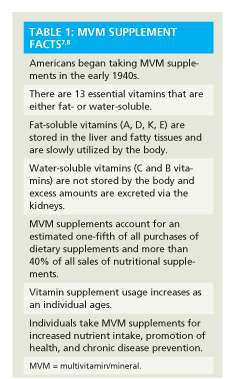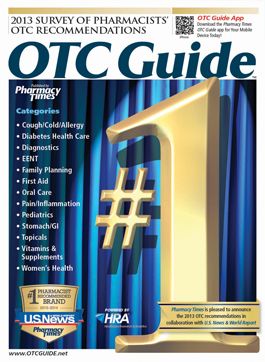Publication
Article
OTC Guide
Multivitamin/Multimineral Supplement Use
Author(s):
Many Americans who take a proactive approach to their health believe that taking a multivitamin/mineral (MVM) supplement is a quick and easy way to ensure that they are obtaining essential nutrients for optimal health. Pharmacy shelves are filled with a host of nutritional supplements. It can be overwhelming for some patients when it comes to selecting products that best suit their nutritional needs.
During counseling, pharmacists should advise patients that nutritional supplements are intended to be used as adjuncts to eating a balanced diet and not as a substitute for eating a healthy variety of foods. Pharmacists also can be very instrumental in assisting patients in the proper selection of these nutritional supplements as well as being an excellent resource in identifying possible drug/micronutrient interactions and contraindications.

While the majority of the population meets their nutritional needs through diet alone, many people still elect to use a daily MVM supplement. Results from a recent study released from the Centers for Disease Control and Prevention’s Division of Laboratory Sciences in the National Center for Environmental Health report that fewer than 10% of the population had nutritional deficiencies.1 While vitamin or mineral deficiencies are rare in the United States, subclinical deficiencies are considered to be contributing factors to chronic diseases.3 Results from a 2012 survey report that an estimated 63% of adults in the United States—or 2 out of 3 individuals—take some type of nutritional supplement. This marks a 3% increase from the previous year.2
Another study conducted by the Centers for Disease Control and Prevention’s National Center for Health Statistics concluded that the use of MVM supplements continues to escalate. It reports that the most common MVM supplements include those that contain calcium, vitamin D, and folic acid.4
MVM Supplement Selection
In 2010, more than $28 billion of nutritional supplements were sold.5 While nutritional supplements are available as single-entity products or combination products, MVM supplements were the top-selling and most popular nutritional supplements among consumers.2-4 Of those surveyed an estimated 56% believed that MVM supplements were essential to maintaining their overall health and fitness goals.2 Results from a large randomized trial released in 2012 suggest that daily MVM supplement use may decrease the risk for cancer in males. The results showed an 8% decrease in total cancer incidence after 11 years of MVM use.6
Table 2: Vitamins and Their Functions 3, 9-11
Vitamins
Function
Signs of Toxicity
1. *Vitamin A (retinol)
Essential for development and maintenance of healthy vision, skin and mucous membrane, bone and tooth development, and immune system
Acute toxicity: Patient may present with headache, photophobia, anorexia, nausea and vomiting, abdominal cramping, drowsiness, irritability, and seizures
2. **Thiamine (Vitamin B1)
Carbohydrate, fat, amino
acid, glucose, and
alcohol metabolism,
central and peripheral
nerve cell function,
myocardial function
Kidneys typically excrete excessive intake and oral doses as high as 500 mg; have been documented as nontoxic when ingested orally
3. **Riboflavin (vitamin B2)
Involvement in
carbohydrate and
protein metabolism,
maintenance of mucous
membranes, and cell respiration
There is little to no risk of vitamin B2 toxicity; no known toxicity concentration; since it is water soluble, excess amounts of the vitamin are excreted via the kidneys and is observed as a bright, fluorescent yellow color in the urine
4. **Folic acid
Maturation of red blood cells
synthesis of purines,
pyrimidines, and
methionine; development of fetal nervous system
Since water soluble, not likely to cause toxicity when taken in oral form
5. **Niacin (Vitamin B3)
Carbohydrate and cell
metabolism; oxidation-reduction reactions
Acute toxicity: Patient may present with flushing, headaches, hypertension, vasodilatation, increased intracranial blood flow, diarrhea, and vomiting
6. **Pyridoxine (B6)
Fatty acid, lipid, and
amino acid metabolism; involvement in nitrogen
metabolism and nucleic acid biosynthesis
Acute toxicity: Patient may present with tachypnea and sensory neuropathies including burning pains, paresthesias, ataxia, clumsiness, paralysis, and numbness
7. **Cobalamins (B12)
Maturation of red blood cells,
neural function, DNA
synthesis, myelin
synthesis, and repair
Since water soluble, not likely to cause toxicity when take in oral form; no known toxic concentration
8. **Vitamin C (ascorbic acid)
Collagen formation; bone and blood vessel health; carnitine, hormone, and
amino acid formation; wound healing
High doses may cause diarrhea, nausea and cramps, and nephrolithiasis (kidney stones)
9. Vitamin D (cholecalciferol,
ergocalciferol)
Calcium and phosphate
absorption, insulin and thyroid
function, improvement
of immune function,
reduction of autoimmune
disease, mineralization and repair of bone, tubular reabsorption of
Ca2+
Acute toxicity: Muscle weakness, apathy, headache, anorexia, irritability, nausea, vomiting, kidney stones, hypercalcemia, and bone pain
10. *Vitamin E (αa-tocopherol, other
tocopherols)
Intracellular antioxidant;
scavenger of free
radicals in biologic
membranes
Acute toxicity: Nausea, gastric distress, abdominal cramps, diarrhea, headache, fatigue, easy bruising and bleeding, muscle weakness
11. *Vitamin K
Formation of
prothrombin, other
coagulation factors,
and bone proteins
No documented toxic concentration
12. **Biotin
Essential for various metabolic functions including carbohydrate, fat and amino, acid metabolism
No known toxicity
13. **Pantothenic acid (vitamin B5)
Precursor of coenzyme A, which is a product that is active in many active biological functions; it has a primary role in cholesterol, steroid, and fatty acid synthesis
Generally considered safe because it is water soluble; no known toxicity or upper limit, although diarrhea and water retention reported in doses of 10 gm or higher
*Vitamins A, D, K, E are fat soluble. ** Vitamins C and B are water soluble.
To make MVM supplement selection easier, many manufacturers are formulating and marketing MVM supplements to address the nutritional needs of various patient populations during all stages of life. Gender-specific formulations are available to meet the unique individual nutritional needs of men and women. In addition, there are MVM supplements formulated with the essential nutrients needed for the pediatric patient population, teenage patient population, adult males before and after the age of 50 years, adult women through childbearing and menopausal years. Specialty MVM supplements formulated with essential nutrients support cardiovascular health, the immune system, ophthalmic health, metabolism, and energy needs. MVM supplements are available in a variety of dosage forms such as chewable tablets, capsules, tablets, liquids, gum balls, and gummies.
Advice from the Pharmacist
Prior to recommending any MVM supplement to patients, especially those in the older population or with pre-existing medical conditions, pharmacists should assess the patient’s medical and medication history and advise patients regarding possible drug/micronutrient interactions or contraindications. For example, calcium, magnesium, and zinc may decrease the absorption of certain antibiotics such as tetracyclines and fluoroquinolines.3,9 Metformin and antiulcer agents may decrease absorption of vitamin B12 and folic acid, while individuals taking antidepressants may present with decreased levels of vitamins B6 , B12, and D.2,9 Vitamin K decreases the anticoagulation effects of warfarin.2,9 (For more information, see online Table 2: Vitamins and Their Functions.)
The most common interactions associated with MVM supplements occur with ascorbic acid and APAP, vitamin D, pyridoxine, and cyanocobalamin with corticosteroids as well as vitamin B3 , folic acid, and vitamin E with ibuprofen.2,9 Patients should always be advised to take the recommended doses of MVM supplements and take supplements with a meal to decrease gastrointestinal upset.2 During counseling, patients should be reminded that these supplements are intended to prevent nutritional deficiencies and maintain nutritional stores and not intended for the self-treatment of vitamin deficiencies.2 Those patients exhibiting signs of nutritional deficiencies should always be referred to their primary health care provider.
Pharmacists should also check for therapeutic duplications in case the patient is taking any other nutritional supplements in order to prevent possible toxicities, especially with the fat-soluble vitamins. Patients should always be encouraged to discuss any concerns with their primary health care provider and adhere to a nutritious diet consisting of a wide variety of foods to ensure balanced and optimal nutrition for an active, healthy life. For more information on MVM supplements, please visit the NIH Office of Dietary Supplements website at http://ods.od.nih.gov/factsheets/list-VitaminsMinerals/.
References
1. Second National Report on Biochemical Indicators of Diet and Nutrition in the U.S. Population. Centers for Disease Control and Prevention website. www.cdc.gov/nutritionreport/pdf/ExeSummary_Web_032612.pdf#zoom=100.
2. “America’s Take on Vitamins” survey reveals: nearly two out of three U.S. adults take vitamins or supplements. PRNewswire website. www.prnewswire.com/news-releases/americas-take-on-vitamins-survey-reveals-nearly-two-out-of-three-us-adults-take-vitamins-or-supplements-151728925.html.
3. Huckleberry Y, Rollins C. Essential and conditionally essential nutrients. In: Krinsky D, Berardi R, Ferreri S. et al, eds. Handbook of Nonprescription Drugs. 17th ed. Washington, DC: American Pharmacists Association; 2012.
4. Dietary supplement use among U.S. adults has increased. Centers for Disease Control and Prevention website. www.cdc.gov/nchs/data/databriefs/db61.htm.
5. Vitamins and supplements: do they work? U.S. News and World Report website. http://health.usnews.com/health-news/articles/2012/05/10/vitamins-and-supplements-do-they-work-2.
6. Gaziano JM, Sesso HD, Christen WG, et al. Multivitamins in the prevention of cancer in men: the Physicians’ Health Study II randomized controlled trial. JAMA. 2012;308(18):1871-1880.
7. Multivitamin/mineral supplements. National Institutes of Health Office of Dietary Supplements website. http://ods.od.nih.gov/factsheets/MVMS-HealthProfessional/.
8. Dietary supplement fact sheet: multivitamin/mineral supplements. National Institutes of Health Office of Dietary Supplements website. http://ods.od.nih.gov/factsheets/MVMS-QuickFacts/.
9. Overview of vitamins. Merck Manual for Healthcare Professionals Online Edition. www.merckmanuals.com/professional/nutritional_disorders/vitamin_deficiency_dependency_and_toxicity/overview_of_vitamins.html#v884545.
10. Rosenblom M. Vitamin toxicity clinical presentation. Medscape website. http://emedicine.medscape.com/article/819426-clinical#a0218.
11. Vitamin-medication interactions pose risks. AAP News, Vol. 31, No. 3, March 1, 2010.
About the Author
Ms. Terrie is a clinical pharmacy writer based in Haymarket, Virginia.







